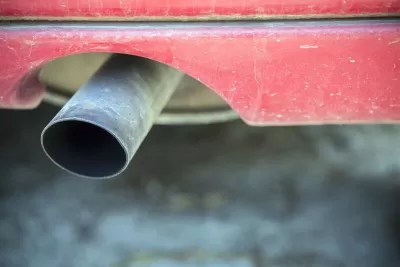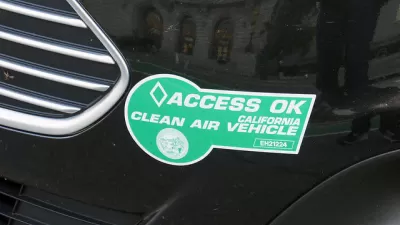California has embraced electric vehicles like no other state, with success reflected in increased sales and registration data, yet transportation emissions have increased for the last four years, primarily from light-duty vehicles.

"More than half the nation’s clean cars reside in California garages and driveways, with sales [pdf] making wild leaps—a nearly 81% increase in registration of new electric vehicles [EVs] between 2017 and 2018, according to the California New Car Dealers Association," writes Julie Cart, environment reporter for CALmatters, a nonpartisan, nonprofit journalism venture. "The transformation [to the decarbonization of transportation] is well underway, but the positive news is clouded by negative trends."
Significant inroads have been made in nudging California toward its near-term goal of about 1 million electric cars by 2023 [per Senate Bill 1275, De León, 2014]. But there’s the added goal of 5 million zero-emission vehicles seven years later.
Almost half of the state's emissions come from transportation (includes some non-tailpipe emissions)
Jared Blumenfeld, secretary of the state Environmental Protection Agency, said pollution from transportation is running counter to trends in most other sectors, at nearly half of greenhouse-gas emissions. That calculation includes energy used to extract and transport fossil fuels; the state Air Resources Board [CARB] counts tailpipe emissions alone, about 40% of the entire emissions inventory.
While the 570,000 electric cars on the road today in California is impressive, it still represents less than 3% of passenger vehicles, notes Cart. And even as Californians buy more EVs, presumably, but not necessarily, replacing their internal combustion vehicles, transportation emissions have increased for that last four consecutive years for which CARB has data, although that slide has been masked by dramatic reductions in greenhouse gas (GHG) emissions from other sectors, primarily electricity generation.
Cart describes several of the "more than 120 laws and incentives encouraging clean fuels and cars," yet she points to a conclusion in a report released last December by the nonpartisan Legislative Analyst’s Office (LAO): “The overall effects of the state’s policies aimed at reducing transportation (greenhouses gases) are largely unclear.” From the executive summary of "Assessing California's Climate Policies—Transportation:"
State policies address four categories of programs to reduce transportation emissions
Overview of Report. AB 398, E. Garcia, 2017 requires our office to annually report on the economic impacts and benefits of California’s statutory greenhouse gas (GHG) emission goals—statewide emissions to 1990 levels by 2020 and to 40 percent below 1990 levels by 2030.
State Has Many Policies to Reduce Transportation Emissions. Transportation is the largest source of California’s GHG emissions—mostly from light‑duty passenger vehicles. Emissions declined from 2006 to 2016, but have increased slightly in recent years. As we discuss in this report, the state has many policies in place to reduce GHG emissions in the transportation sector.
The major categories of programs include (1) reducing emissions from light‑duty vehicles, (2) reducing emissions from heavy‑duty vehicles, (3) increasing the use of lower carbon fuels, and (4) reducing the number of vehicle miles traveled [VMT].
[See related post on the increase in VMT based on a California Air Resources Board (CARB) report last November on the failure to meet SB 375 (2008) goals.]
As shown in Figure 3 [png] of the report, overall transportation emissions declined by 14 percent from 2007 to 2011. A CALmatters infogram shows that transportation emissions increased by 1% in 2013, 1% in 2014, 3% in 2015, and 2% in 2016, "primarily from light-duty vehicles."
Not enough EVs being sold?
Last year, 81.7% of light-duty vehicles were powered solely be gasoline, according to California New Car Dealers Association sales data.
“The reality is that our (zero-emission-vehicle) mandate is not very aggressive at this point,” said Dan Sperling, who sits on the Air Resources Board and is the founding director of the Institute of Transportation Studies at UC Davis. “The increase in electric vehicles has been significant, but if you pull out Tesla, there’s been almost no change...”
Although the most recent official emissions inventory ends at 2016, Sperling said trends continue to suggest that transportation emissions are increasing.
Assemblyman Phil Ting (D-San Francisco), who authored legislation in 2017 to increase the $2,500 rebate most EVs receive, and introduced bills in 2018 and this year to end sales of light-duty vehicles powered by internal combustion engines, tells Cart, "From a regulatory point of view, we need to do more.”
However, one of the three "key takeaways" from the LAO report was that the 120 current regulations, laws, and incentives "are generally more costly strategies to reduce GHGs than alternatives, such as cap‑and‑trade, although they could provide other important benefits in certain limited circumstances." See the paragraph entitled, "Large Number of Policies Targeting Transportation Emissions Creates Challenges."
Cart explores the challenges of increasing EV sales from many angles. “Only about 15% of new car buyers say they would be willing to consider buying an electric vehicle, and that number hasn’t changed in three or four years,” said Lew Fulton, a UC Davis transportation researcher.
“We are not selling a lot of new cars to poor people,” said Gil Tal, who studies travel behavior at the UC Davis transportation think tank.
Tal expressed concern that the income threshold (see post on SB 1275, DeLeon, 2014) for EV rebates will have a detrimental effect on used EV sales. "That cap was originally set at $250,000 in annual income for a single tax filer. In 2016, it was lowered to $150,000," notes Cart.
Nearly half of California households have not purchased a new car in the last seven years, Tal said. “We should not punish the repeat buyers; we need these guys to buy a lot of cars.”
Cart writes extensively about the challenges of increasing EV sales. The article is not about reducing vehicle miles traveled, though she does mention the defeat of Senate Bill 50, the More HOMES Act, on Thursday, the same day the article was published. Yet even that defeat is coupled with a new law that may have a negative impact on EV sales, taking away the focus on the nexus of housing, land use, and transportation.
The exemption electric-vehicle drivers had from paying a share of roadway maintenance via gasoline taxes was addressed in last year’s state gas-tax increase, which required an additional $100 annual registration fee for electric vehicles [effective next year]. And policies enacted in the past couple of years are intended to reduce miles traveled by encouraging multi-unit housing clustered around transportation hubs, though a highly controversial bill to further foster such moves has been held until next year.
However, SB 50's defeat did not go unnoticed by other writers concerned about the increase in transportation emissions. Ethan Elkind, who directs the climate program at the Center for Law, Energy and the Environment (CLEE) at UC Berkeley Law, wrote about the controversial bill's defeat on Friday, noting that in addition to addressing the state's massive housing shortage, it also mitigated "an increase in driving miles and related greenhouse gas emissions which threaten to undermine the state’s progress achieving its climate goals." His post is centered on the state Senate Appropriations Committee chair who suspended the bill: "Sen. Portantino Spikes California’s Critical Housing & Climate Legislation."
Related in Planetizen:
-
U.S. Risks Becoming Backwater for Electric Vehicle Sales, March 11, 2019
-
Report: Transportation Emissions Sully California's Environmental Reputation, September 6, 2018
-
Too Much Driving is Spoiling California's Emissions Report Card, August 24, 2017
FULL STORY: Despite sharp growth in electric cars, vehicle emissions keep rising

Maui's Vacation Rental Debate Turns Ugly
Verbal attacks, misinformation campaigns and fistfights plague a high-stakes debate to convert thousands of vacation rentals into long-term housing.

Planetizen Federal Action Tracker
A weekly monitor of how Trump’s orders and actions are impacting planners and planning in America.

In Urban Planning, AI Prompting Could be the New Design Thinking
Creativity has long been key to great urban design. What if we see AI as our new creative partner?

King County Supportive Housing Program Offers Hope for Unhoused Residents
The county is taking a ‘Housing First’ approach that prioritizes getting people into housing, then offering wraparound supportive services.

Researchers Use AI to Get Clearer Picture of US Housing
Analysts are using artificial intelligence to supercharge their research by allowing them to comb through data faster. Though these AI tools can be error prone, they save time and housing researchers are optimistic about the future.

Making Shared Micromobility More Inclusive
Cities and shared mobility system operators can do more to include people with disabilities in planning and operations, per a new report.
Urban Design for Planners 1: Software Tools
This six-course series explores essential urban design concepts using open source software and equips planners with the tools they need to participate fully in the urban design process.
Planning for Universal Design
Learn the tools for implementing Universal Design in planning regulations.
planning NEXT
Appalachian Highlands Housing Partners
Mpact (founded as Rail~Volution)
City of Camden Redevelopment Agency
City of Astoria
City of Portland
City of Laramie





























